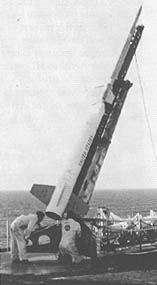 A Nike-Apache aboard USNS Croatan | |
| Function | Sounding rocket |
|---|---|
| Manufacturer | Aerolab/Atlantic Research |
| Country of origin | United States |
| Cost per launch | $6,000 USD |
| Size | |
| Height | 8.53 m (28.0 ft) |
| Diameter | 0.42 m (1 ft 5 in) |
| Mass | 727 kg (1,603 lb) |
| Stages | Two |
| Payload to 160 km (99 mi) | |
| Mass | 45.4 kg (100 lb) |
| Launch history | |
| Status | Retired |
| Launch sites | Multiple |
| Total launches | 636 |
| First flight | 17 February 1961 |
| Last flight | 27 September 1978 |
| First stage – Nike | |
| Diameter | 0.42 m (1 ft 5 in) |
| Powered by | 1 x ABL M5 |
| Maximum thrust | 217 kN (49,000 lbf) |
| Burn time | 3.5 s |
| Propellant | solid |
| Second stage –Apache | |
| Diameter | 0.165 m (6.5 in) |
| Powered by | 1 x Thiokol TE-307-2 |
| Maximum thrust | 21.1 kN (4,700 lbf) |
| Burn time | 6 s |
| Propellant | solid |
The Nike Apache,also known as Argo B-13,was a two-stage sounding rocket developed by Aerolab,later Atlantic Research,for use by the United States Air Force and NASA. It became the standard NASA sounding rocket and was launched over 600 times between 1961 and 1978.